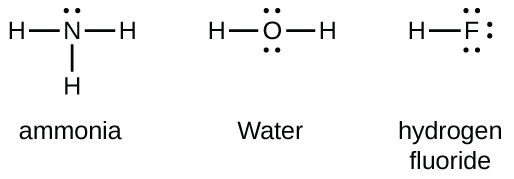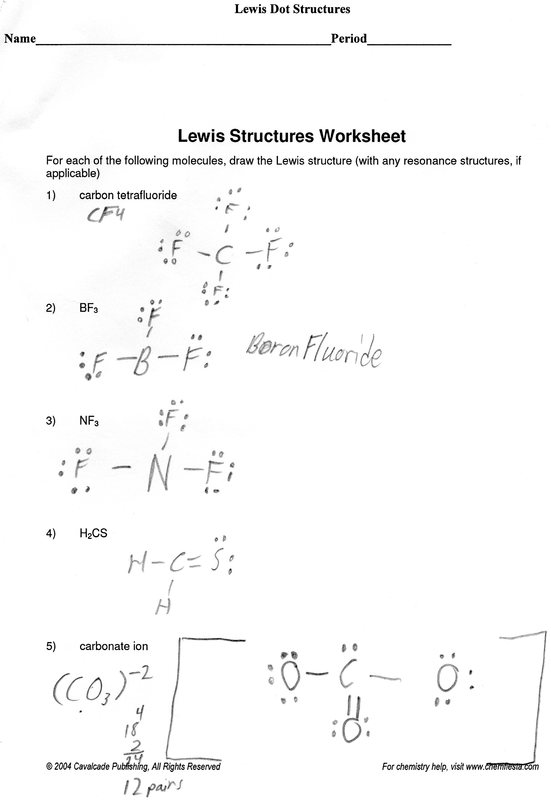In 1916, ten years before the Schrodinger wave equation, G. N. Lewis suggested that a chemical bond involved sharing of electrons. He described what he called the cubical atom
, because a cube has 8 corners, to represent the outer valence shell electrons which can be shared to create a bond. This was his octet rule.
- Count the number of valence e- each atom brings into the molecule.For ions, the charge must be taken into account.
How many valence electrons in BeCl2?
How many valence electrons in NO2- and NO2+?
- Put electron pairs about each atom such that there are 8 electrons around each atom (octet rule), with the exception of H, which is only surrounded by 2 electrons. Sometimes it's necessary to form double and triple bonds. Only C, N, O, P and S (rarely Cl) will form multiple bonds.
Draw the Lewis dot structure for CF4.
The number of valence electrons is 4 + 4 ( 7 ) = 32 electrons.
So, we obtain:
Draw the Lewis dot structure for CO.
The number of valence electrons is 4 + 6 = 10 electrons or 5 pairs. Since both C and O allow multiple bonds we can still follow the octet and write:
- If there is not enough electrons to follow the octet rule, then the least electronegative atom is left short of electrons.
Draw the Lewis dot structure for BeF2.
In BeF2 number of valence e- = 2+ 2(7) = 16 e- or 8 pairs. Since neither Be or F form multiple bonds readily and Be is least electronegative we obtain:
- If there are too many electrons to follow the octet rule, then the extra electrons are placed on the central atom.
Draw the Lewis dot structure for SF4.
In SF4 the number of valence electrons is 6 + 4 ( 7 ) = 34 electrons or 17 pairs. Placing the extra electrons on S we obtain:
Drawing the Lewis Structure for Cl 2 CO. Viewing Notes: The Lewis structure for Cl 2 CO requires you to place Carbon in the center of the structure since it is the most electronegative. You'll need a double bond between the Carbon and Oxygen atoms to acheive full outer shells for the atoms while still only using 24 valence electrons. Using Lewis Dot Symbols to Describe Covalent Bonding The valence electron configurations of the constituent atoms of a covalent compound are important factors in determining its structure, stoichiometry, and properties. For example, chlorine, with seven valence electro. In this lesson students learn how to write Lewis Structures for covalent compounds. This builds on their prior knowledge of how to write Lewis Structures for Ionic Compounds from Unit 3 Lesson 4 and students knowledge of Covalent Compounds from Unit 3 Lesson 6. This lesson aligns with NGSS Performance Expectation: HS-PS1-2: Construct and revise an explanation for the outcome of a simple. If the electrons are shared equally between the atoms then its a non-polar covalent bond. If one of the atom is electronegative, it has more tendency to attract the electrons. Then the bond is called as polar covalent bond. This calculator is used to find the bond polarity and tendency of electro-negativity in each element.
How can the octet rule be violated in this last example? The octet rule arises because the s and p orbitals can take on up to 8 electrons. However, once we reach the third row of elements in the periodic table we also have d-orbitals, and these orbitals help take the extra electrons. Note that you still need to know how the atoms are connected in a polyatomic molecule before using the Lewis-Dot structure rules.
Homework from Chemisty, The Central Science, 10th Ed.
Covalent Lewis Dot Structure Calculator Answer
8.45, 8.47, 8.49, 8.51, 8.53, 8.55, 8.57, 8.59, 8.61, 8.63
ALL questions listed must be answered to earn credit for completing the text homework. Yes, even the Additional Exercises if they are present for this chapter.
Covalent Compounds
(1) How do atoms form covalent bonds? What is the easiest way to distinguish a covalent bond from an ionic bond?
(2) For each of the following elements, draw their Lewis dot structures.
- Sulfur
- Boron
- Iodine
- Silicon
- Phosphorus
(3) Study the given Lewis structure and provide the following information:
- Draw in any lone pairs that are needed.
- How many bonding electrons does the carbon have? How many does Oxygen have?
- Is the octet of each atom in the molecule satisfied?
- How many single bonds are used in this molecule? How many double bonds?
- How many bonds are shared between the Carbon and Oxygen atoms? How many are shared between the Carbon and each Hydrogen?
(4) Answer each question regarding the following structure:
- Fill in all missing lone pairs
- How many bonding electrons does the Nitrogen have? How many non-bonding electrons does it have?
- How many bonding electrons do each Chlorine have? How many non-bonding electrons do they each have?
- How many electrons, in total, does Nitrogen share with all three Chlorines? Does each atom have an octet?
- Are the bonds formed in this molecule ionic or covalent?
(5) Draw the Lewis dot structures for each of the 7 diatomic elements in their diatomic states. Are these diatomic elements, when one atom is covalently bonded to another of the same element, considered molecules or compounds? Explain using the definition of whichever answer you choose.
(6) For each family or group number, describe the covalent bonding pattern found in organic compounds.
- Halogens
- Group 4A
- Group 6A
- Group 5A
- Noble Gases
(7) Sketch the Lewis configurations for the following molecules. Include all lone pairs in the sketch and determine how many total electrons are in each molecule.
- CH2Cl2
- HCN
- CH2O
- CH3CH2CH3
- CH3COOH (Hint: Both oxygens bond to the second carbon)
(8) What is an expanded octet? Which elements cannot form an expanded octet? Where on the periodic table are the elements that can form expanded octets located?
(9) Give the names of the following covalent compounds.
- N2O4
- SCl6
- CBr4
- P2O5
- ClF7
Three-Dimensional Shapes of Molecules

(10) Include the Lewis dot structure for each given molecule. Give both the electron geometry and molecular shape of the central atom(s).
- CH3F
- H2O
- NH2I
- CH2S

(11) If a central atom has three bonding groups surrounding it, how can you differentiate between the possible molecular shapes it can take on? What electron geometry, molecular shape and bond angles would such a molecule have?
(12) For each of the following molecules, tell whether they are two-dimensional or three-dimensional based on their electron geometry.
- NH3
- H2S
- CH2Cl2
- CH2S
- CO2
(13) What are the approximate bond angles in the given molecules?
Lewis Dot Structure Calculator With Dots
- PBr3
- HNO
- CH3F
- CH2O
- CS2
(14) In each of the following molecules, give the central atom’s molecular shape and the approximate bond angles.
a. O=C=O
b.
c. NH3
d.
e.
(15) Use your knowledge of what you’ve learned so far to provide the Lewis dot structures, electron geometry, molecular shape, bond angles, number of lone pair electrons, and the number of shared pair electrons for each molecule given.
- CI2Br2
- NOF
- ClCN
- CH2O
(16) For each of the three carbons in this molecule, provide the requested information.
- The molecular shape of each carbon
- Is this molecule more likely to be two-dimensional or three dimensional?
- What is the bond angle of the CH2?
- What is the H-C-C bond angle?
- What is the C-C-N bond angle?
Modeling Exercises
(17) Construction of acetic acid, CH3COOH
- Obtain two carbons, four hydrogens, and two oxygens with six single-bond sticks and two double-bond sticks
- Sketch the Lewis dot structure to get an idea of how to put it together
- Construct the model to get a three-dimensional visual of acetic acid
- For each carbon atom, how many different electron groups, both bonding and non-bonding, surround them?
- Of those groups and for each carbon, respectively, how many are bonding and how many are non-bonding?
- What is the electron geometry around each carbon? Molecular shape?
- Is the majority of the molecule two-dimensional, or three-dimensional? Justify. (Hint: Try rotating some of the central atoms and looking at it from different angles.)
- What are the bond angles on each central atom (remember to include the oxygen in the -OH as one of the central atoms.)
- Why does one of the two oxygen atoms get treated as a central atom and not the other?
(18) Construction of acetonitrile, CH3CN
- Obtain two carbons, three hydrogens and a nitrogen, four single-bond sticks and three double-bond sticks.
- Sketch the Lewis dot structure of the molecule to determine its structure.
- Construct the model of the molecule for a visual representation.
- How many non-bonding electrons does each carbon have? Bonding electrons?
- Determine the electron geometry and molecular shape of each carbon.
- Is the nitrogen a central atom or not? Explain.
- What is the electron geometry of the nitrogen? What is the molecular shape?
Molecular Polarity
(19) Between the following pairs, which has the higher electronegativity?
- Oxygen and Nitrogen
- Sulfur and Oxygen
- Chlorine and Bromine
- Carbon and Silicon
- Phosphorus and Nitrogen
(20) Describe the trend in electronegativity as you move left and right across the periodic table. Does electronegativity increase to the right or the left? Now do the same for moving up and down; does electronegativity increase as you go up or down?
(21) Sketch each of the following molecules to help you determine whether they are polar or non-polar. Draw dipole arrows to indicate polarity in polar molecules.
- CCl4
- PH3
- HOCl
- CS2
- HCOOH
(22) Electronegativity is not the sole decider of polarity within a molecule. Keeping this in mind, determine if the following molecules are polar or not. If not, explain why.
- CH2F2
- CO2
- CH3CH3
- H2O
- CH3OCH3
Intermolecular Forces of Attraction
(23) Are intermolecular forces considered to be bonds? Explain. Is an H-bond an exception?
(24) Which of the three intermolecular forces is the most common? List two other names that can be used to describe this interaction. What is its relative strength compared to the others?
(25) Explain why a dipole-dipole attraction is a stronger force than London Dispersion forces. What is the critical difference that makes this so?

(26) What is the dominant intermolecular forces in each of the following molecules?
- CH2CH2
- CH3OH
- HCN
- CH3OCH3
- NH3
Covalent Lewis Dot Structure Calculator Worksheet
(27) Water (H2O) is one of the most perfect H-bonding molecules we know of. Use your knowledge of H-bonding to explain why solid H2O (ice) floats in liquid H2O while in most other substances, the density of the solids is greater than their respective liquids.
Lewis Dot Diagram Calc
(28) Intermolecular forces are significant for allowing molecules to do things that bonding alone will not allow for. Explain how something like DNA utilizes intermolecular forces to take on its helical shape without relying solely on covalent bonding.